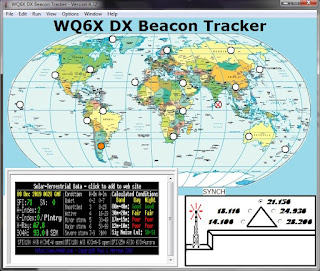 |
| D F 8 D X & N 6 K I |
Considering that the last 1/2-dozen contest weekends have been loaded with crappy Space-WX, this weekend was AMAZINGLY Quiet.
This year's ARRL-160 contest began at 23:00z on Friday; 3pm California time. Being a typical 30-hour ARRL contest,
it ended at 16:00z (9am California time)
on Sunday. Initially, Dennis (N6KI) could find no other available operators for a Multi-Single setup except WQ6X and
Axel KI6RRN.
Late Saturday afternoon a visit from DF8DX brought B-I-C (Butt-in-Chair) action to the NX6T shack. Bodo ran STN-2 during the 7:00 to 10:30 "dinner hour"; I usually run STN-1 remotely during that time-period. Thanks to DF8DX, I was confident that NX6T was in capable hands, giving me the freedom to put 22 QSOs in the WQ6X ARRL-160 Log.
N6KI and WQ6X ran NX6T remotely Friday evening; Ron running STN-1 via RCForb and Dennis running STN-2 via an Elecraft K3/0. KI6RRN also put some QSOs in the log, but we never crossed paths so I dunno when he was actually on the air. Space WX-wise, 160-meters was incredibly quiet; both in Fallbrook (SDG section) and Concord (EB section). Unfortunately signal levels were often weaker than usual. Then again, one of the weak-signal surprises was from IK0XBX; not bad from San Diego using only an Inverted Vee.
While we got a late start (03:45z), N6KI quickly made over 160 QSOs in just under 2 hours. It's a nice feeling to start an operating session knowing that team members have been keeping the NX6T call in bandmaps all over North America, as well as around the world. Continuing to run on 1805.71 found me keeping alive a busy frequency, interspersed with "popping" multipliers from the bandmap.
Amazingly, by contest-end we managed to work all sections except NT.
A move to 1806.06 put his puny (but annoying) signal out of the passband; not working anybody
he eventually disappeared.
For this weekend I accomplished what I set out to do; run NX6T remotely from Concord via my Elecraft K3/0 and test-run the recently devised WQ6X Lazy 8JK Inverted Vee (converted from the original Lazy 8JK Sloper). As a Lazy 8JK Sloper, on 160-meters the antenna could barely work N6RO (5-mi away); as a Lazy 8JK Inverted Vee, the WQ6X signal was able to work nearly
all of the Northwest states and as far as Colorado. As a sloper, the 8JK was a noisier antenna
than the CH-250 Vertical next to it; as an Inverted Vee it is now much quieter than the vertical.
Around 03:00z on Saturday, I noticed on the webcam that N6KI and DF8DX had arrived @NX6T putting B-i-C for 3 hours. It was during this time that WQ6X managed to make 22 QSOS; one of which was a reply to my CQ call from NX6T (manned by DF8DX). Around 06:30z NX6T was again dark; the only "light on" being from Station #1 being run by me remotely until N6KI returned to San Diego (07:30z) to run Station #2 until I took over at 10:30z to wrap things up. |
| WQ6x scribbled contest projections .VS. 3830Scores.Com |
Based on scores reported (or should we say, scores NoT reported) to the 3830Scores website, it would seem that WQ6X took 2nd place for W6 and IARU Zone 6, 1st place for East Bay section
and surprisingly, 1st place for Pacific Division.
While the solar flux for this year's ARRL 160 contest was depressingly low, I need to remember that low-SFI's make for GREAT 160 contests; we'll know more after the upcoming Stew Perry 160 contest.
DiD You work the ARRL 160 Meter contest?
What band condx. did you encounter?
Is WQ6X or NX6T in YOUR LoG?




No comments:
Post a Comment